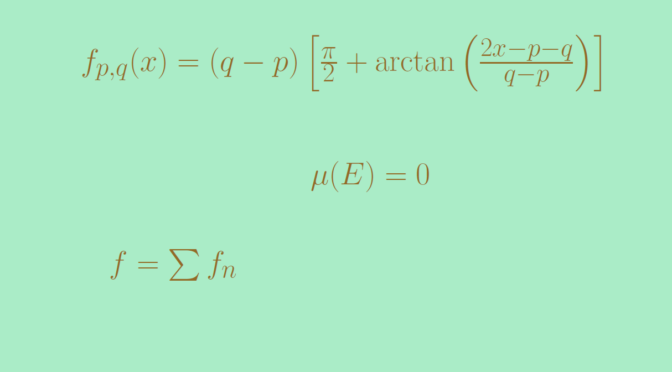This article is a follow-up of Counterexamples on real sequences (part 2).
Let \((u_n)\) be a sequence of real numbers.
If \(u_{2n}-u_n \le \frac{1}{n}\) then \((u_n)\) converges?
This is wrong. The sequence
\[u_n=\begin{cases} 0 & \text{for } n \notin \{2^k \ ; \ k \in \mathbb N\}\\
1- 2^{-k} & \text{for } n= 2^k\end{cases}\]
is a counterexample. For \(n \gt 2\) and \(n \notin \{2^k \ ; \ k \in \mathbb N\}\) we also have \(2n \notin \{2^k \ ; \ k \in \mathbb N\}\), hence \(u_{2n}-u_n=0\). For \(n = 2^k\) \[
0 \le u_{2^{k+1}}-u_{2^k}=2^{-k}-2^{-k-1} \le 2^{-k} = \frac{1}{n}\] and \(\lim\limits_{k \to \infty} u_{2^k} = 1\). \((u_n)\) does not converge as \(0\) and \(1\) are limit points.
If \(\lim\limits_{n} \frac{u_{n+1}}{u_n} =1\) then \((u_n)\) has a finite or infinite limit?
This is not true. Let’s consider the sequence
\[u_n=2+\sin(\ln n)\] Using the inequality \(
\vert \sin p – \sin q \vert \le \vert p – q \vert\)
which is a consequence of the mean value theorem, we get \[
\vert u_{n+1} – u_n \vert = \vert \sin(\ln (n+1)) – \sin(\ln n) \vert \le \vert \ln(n+1) – \ln(n) \vert\] Therefore \(\lim\limits_n \left(u_{n+1}-u_n \right) =0\) as \(\lim\limits_n \left(\ln(n+1) – \ln(n)\right) = 0\). And \(\lim\limits_{n} \frac{u_{n+1}}{u_n} =1\) because \(u_n \ge 1\) for all \(n \in \mathbb N\).
I now assert that the interval \([1,3]\) is the set of limit points of \((u_n)\). For the proof, it is sufficient to prove that \([-1,1]\) is the set of limit points of the sequence \(v_n=\sin(\ln n)\). For \(y \in [-1,1]\), we can pickup \(x \in \mathbb R\) such that \(\sin x =y\). Let \(\epsilon > 0\) and \(M \in \mathbb N\) , we can find an integer \(N \ge M\) such that \(0 < \ln(n+1) - \ln(n) \lt \epsilon\) for \(n \ge N\). Select \(k \in \mathbb N\) with \(x +2k\pi \gt \ln N\) and \(N_\epsilon\) with \(\ln N_\epsilon \in (x +2k\pi, x +2k\pi + \epsilon)\). This is possible as \((\ln n)_{n \in \mathbb N}\) is an increasing sequence and the length of the interval \((x +2k\pi, x +2k\pi + \epsilon)\) is equal to \(\epsilon\). We finally get \[ \vert u_{N_\epsilon} - y \vert = \vert \sin \left(\ln N_\epsilon \right) - \sin \left(x + 2k \pi \right) \vert \le \left(\ln N_\epsilon - (x +2k\pi)\right) \le \epsilon\] proving that \(y\) is a limit point of \((u_n)\).










